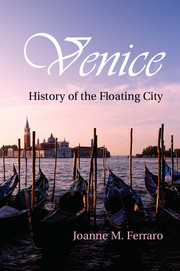Book contents
- Frontmatter
- Contents
- Plates
- Illustrations
- Maps
- Acknowledgments
- Preface
- Chronology of Historical Events
- 1 Reconstructing the Floating City
- 2 The Riches of Asia, Europe, and North Africa
- 3 A Pride of Lions
- 4 Identities and Modes of Socialization
- 5 Material Life
- 6 City of Myth
- 7 The Serenissima’s Wayward Subjects
- 8 The Baroque Stage
- 9 Epilogue
- Appendix I Approximate Population of Venice during the Republic
- Appendix II Population of the Historic Center of Venice, 1871–2010
- Glossary
- Notes
- Bibliography
- Index
- Plate Section
- References
4 - Identities and Modes of Socialization
Published online by Cambridge University Press: 05 August 2012
- Frontmatter
- Contents
- Plates
- Illustrations
- Maps
- Acknowledgments
- Preface
- Chronology of Historical Events
- 1 Reconstructing the Floating City
- 2 The Riches of Asia, Europe, and North Africa
- 3 A Pride of Lions
- 4 Identities and Modes of Socialization
- 5 Material Life
- 6 City of Myth
- 7 The Serenissima’s Wayward Subjects
- 8 The Baroque Stage
- 9 Epilogue
- Appendix I Approximate Population of Venice during the Republic
- Appendix II Population of the Historic Center of Venice, 1871–2010
- Glossary
- Notes
- Bibliography
- Index
- Plate Section
- References
Summary
A World City
Much has been said about the constitutional elite, whose dynastic lines to some degree provided great social continuity in Venice, but who in general were the Venetians? The progeny of the original island settlers, whether noble or common, would persistently vaunt their antiquity in the city’s collective memory through the ages. However, Venice had shed its insularity by the year 1000 and, like all cities, its native population was regularly replenished with newcomers. Pilgrims, tourists, seamen, merchants, laborers, and exiles repeatedly infused the urban fabric with new energies.
There were several catalysts for immigration. Among them were the waves of catastrophic mortality, brought on by famines and epidemics. After the devastating Black Death of 1348–9, there were repeated visitations of the plague, with fourteen outbreaks between 1456 and 1528. The epidemics of 1575 and 1630 were particularly savage, taking between 25 percent and 30 percent of the population each time (Fig. 17). Each cycle of demographic depletion prompted concerned authorities to provide economic incentives to newcomers, not only to rebuild the labor market but also to repair the truncated families and to fill vacant houses. The Venetian turn to mainland Italy at the start of the fifteenth century, coupled with the disruption caused by the Italian wars, also attracted residents to the new capital city from the periphery. Villagers steadily migrated to the lagoon city from places in the hinterland as well as the Adriatic Coast to seek a better life. Many found work in the burgeoning woolen industry. Yet another development that triggered relocation to Venice was the collapse of Byzantium to the Ottoman Turks in 1453. The city attracted Greek and Jewish merchants and scholars. Similarly, the expulsion of the Jews from Spain in 1492 and the sack of Rome in 1527 triggered additional diasporas of talented groups and individuals to the Venetian lagoon. Finally, the Venetian economy was a powerful magnet for immigration. Trade incentives consistently brought droves of northern Europeans, particularly from Germany and Flanders, to the medieval commercial center through the fifteenth century, while in the sixteenth century, in addition to becoming a haven for intellectuals and workers in the printing industry, Venice developed into one of the most industrialized cities of Europe.
- Type
- Chapter
- Information
- VeniceHistory of the Floating City, pp. 75 - 105Publisher: Cambridge University PressPrint publication year: 2012



